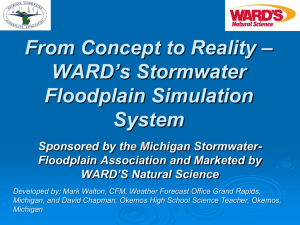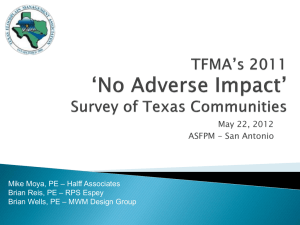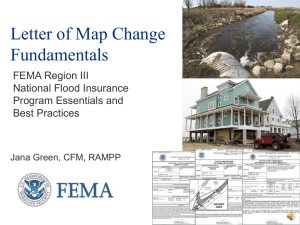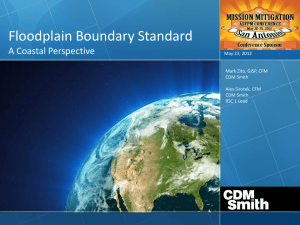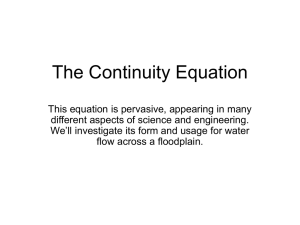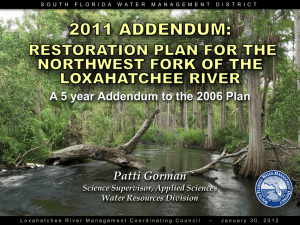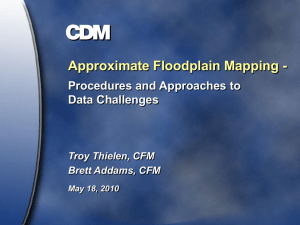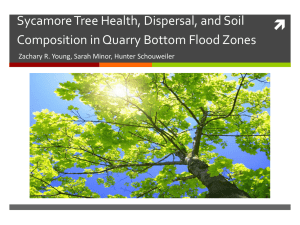Presentation title slide - 42 pt Times New Roman, White
advertisement
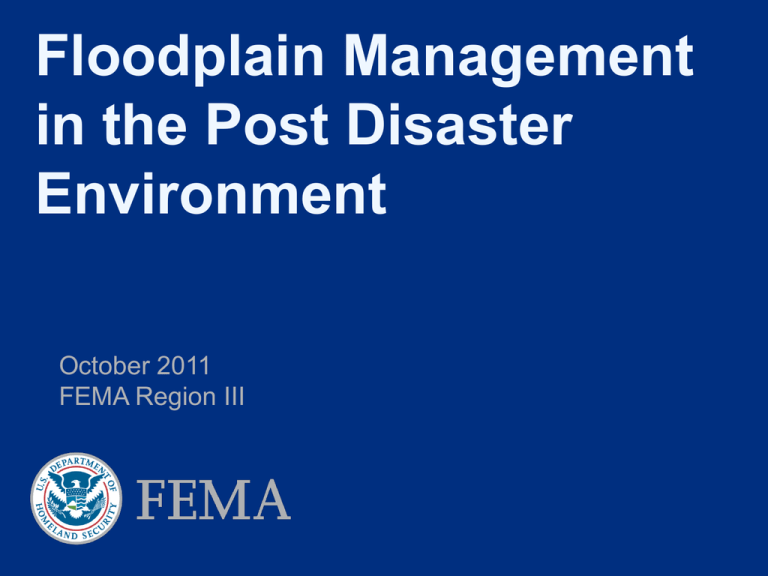
Floodplain Management in the Post Disaster Environment October 2011 FEMA Region III Course Outline Background of the NFIP Mapping The Permitting Process Your Floodplain Management Ordinance BREAK Substantial Damage/Improvement Higher Standards Insurance at a Glance Legal Concerns Post Disaster Outreach Long Term Recovery Summary of Roles and Responsibilities Floodplain Management 2 The Evolution of the NFIP Floodplain Management 3 Goals of the NFIP 1. Save lives and reduce flood damage to insurable property, 2. Offer low cost flood insurance 3. Encourage a comprehensive approach to floodplain management. Floodplain Management 4 Benefits of Flood Insurance ANYONE in a NFIP participating community can buy flood insurance! Can you describe the differences between flood insurance and disaster assistance? Floodplain Management 5 Types of Flood Damage Hydrodynamic forces Hydrostatic forces Debris impact Soaking Sediment and contaminants Floodplain Management 6 Mapping Floodplain Management 7 Flood Insurance Study - FIS Floodplain Management 8 Mapping Where to look at preliminary maps: http://www.rampp-team.com/pa.htm Existing maps at FEMA Map Services Center: http://www.msc.fema.gov How to make a FIRMette: http://www.rampp-team.com/documents/region3/ how_to_create_a_firmette.pdf Floodplain Management 9 Letters of Map Change LOMCs Letter of Map Amendment (LOMA) Conditional Letter of Map Revision (CLOMR) Letter of Map Revision (LOMR) Letter of Map Revision Based on Fill (LOMR-F) Floodplain Management 10 Federal Minimum Requirements Require permits Elevate residential & elevate/dry flood proof nonresidential structures Use flood resistant materials Elevate and anchor utilities Limit development in floodways Minimize/eliminate flood damage to public utilities/facilities Anchor all structures Floodplain Management 11 What Is “Development” Modifications or improvements to structures, excavation, filling, paving, drilling, driving of piles, mining, dredging, land clearing, grading and the permanent storage of materials/equipment. ALSO covers replacement of utilities, including wiring, hot water heaters, HVAC, etc. Floodplain Management 12 Permitting Application form needs to include Federal minimums, State and your local ordinance requirements Get a site plan Does it have a floodplain determination? Review for completeness and compliance Post Disaster you can waive fees but not permitting requirements! Floodplain Management 13 Permit Sample Floodplain Management 14 Elevation to the BFE At a minimum you must elevate the lowest floor to the BFE Freeboard is a margin of safety above that NO BASEMENTS in the SFHA How do you establish BFEs in an un-numbered A zone? Elevate and anchor utilities too Floodplain Management 15 Floodproofing Only for non-residential or historic structures Must be certified by a registered architect or engineer Dry-floodproofing vs wet-floodproofing Utilities can be floodproofed too Floodplain Management 16 Floodways Until a regulatory floodway is designated, no new construction, substantial improvements, or other development shall be permitted unless it is demonstrated that the cumulative effect of the proposed development, when combined with all other existing and anticipated development, will not increase the water surface elevation of the base flood more than 1.0 foot at any point within the community. Floodplain Management 17 Openings Prevent hydrostatic flood forces from collapsing the foundation by allowing water pressure to equalize on either side of the wall. A minimum of 2 openings on 2 different walls with one square inch of surface for every square foot of enclosed space. 150 square feet = 150 inches. Bottom of openings must be located no higher than 1 foot above grade. Can be fitted with screens or louvers that allow the AUTOMATIC entry and exit of water. Engineered openings are acceptable with certification. Floodplain Management 18 Fill in the Floodplain No fill shall be permitted unless it meets the requirements of your ordinance. All fill placed in the special flood hazard area shall meet or exceed the standards in your ordinance Fill shall be used only to the extent to which it does not adversely affect adjacent properties. Floodplain Management 19 Manufactured Homes and Recreational Vehicles Communities may elect to PROHIBIT manufactured homes in the SFHA. Examine your pre-existing structure language and floodplain ordinance for options to prevent replacing a substantially damaged manufactured home with a replacement one. Must be placed on a permanent foundation, at least 18 inches above BFE, properly anchored to resist flotation, collapse or lateral movement. Recreational Vehicles: on site less than 180 days, licensed and road-ready OR meet manufactured homes guidelines above. Floodplain Management 20 BREAK Floodplain Management 21 PA Suggested Provisions Largely minimum requirements for NFIP & Act 166 Higher standards include: 1 ½ feet of freeboard Restrictions on hazardous material storage Regulated high risk land uses (including manufactured homes) 50 foot Setbacks/ Buffers Repetitive Loss Conservation/open space area Estimate BFE in Zone A Lower threshold for SD Floodplain Management 22 Community Identified Flood Areas The __(Community)___ may identify and regulate new local flood hazard or ponding areas. These areas may be delineated on a “Local Flood Hazard Map” using best available topographic data and locally derived information such as flood of record, historic high water marks or approximate study methodologies. Floodplain Management 23 Subdivision Restrictions Lower threshold for BFE determination from 50 lots and 5 acres Require each lot to have a portion of land outside the SFHA 280 275 Zone A Floodplain Management 24 Non Conversion Agreements A Non Conversion Agreement shall be signed by the applicant whenever the community determines that the area below the first floor could be converted to a non-conforming use (generally applies to enclosed areas below base flood elevation that are 5 ft. high or more). Floodplain Management 25 Historic Structures Communities have the option of using either provision (exclusion from substantial damage/improvement definition OR variance) for addressing the unique needs of “historic structures.” Relying on the variance option gives a community more control over which floodplain safety methods are incorporated into the design. Floodplain Management 26 Verification of Compliance As Built Elevation Certificates CLOMR/LOMR Certificate of Occupancy compared to Certificate of Compliance Permanent Utility Connection Floodplain Management 27 Substantial Improvement/Damage The threshold is 50% of fair market value. How do you determine market value? Use a Substantial Damage Estimator Community must determine whether property can be restored or must meet current ordinance requirements. Consider adding cumulative language to your ordinance Floodplain Management 28 Substantial Damage Determination Assess Damage Make Substantial Damage Determinations Notify Damaged Structures of Ordinance Requirements Less Than Substantially Damaged Use Flood Resistant Materials Below BFE Elevate Utilities At or Above BFE Substantially Damaged Use Flood Resistant Materials Below BFE Elevate Utilities At or Above BFE Floodplain Management Elevate Lowest Floor At or Above BFE Floodplain Management 30 Floodplain Management 31 Sample Substantial Damage Letter Floodplain Management 32 Freeboard NFIP premiums based on October 2011 rates One-floor residential structure with no basement built Post-FIRM $250,000 coverage for the building and $100,000 for contents At BFE Insurance Premium: $1,315 building, $380 contents Zone AE Annual NFIP Insurance Savings Savings Over 30 Year Mortgage 1 ft. below BFE -$3,415 -$102,450 At BFE 0 0 1 ft. freeboard $675(49%) $20,250 2 ft. freeboard $911 (69%) $27,330 3 ft. freeboard $983 (75%) $29,490 Floodplain Management 33 Insurance at a Glance Anyone in a NFIP participating community can get flood insurance All properties with federally backed mortgages that are located in the SFHA must carry flood insurance. Elevation Certificates are needed for ratings Non compliant structures will pay more! Pre FIRM vs Post FIRM w Floodplain Management 34 www.floodsmart.gov Floodplain Management 35 Increased Cost of Compliance - ICC Property must be insured through the NFIP Structure must be in the Special Flood Hazard Area (SFHA) Structure must be substantially damaged Eligible for up to $30,000 to elevate (floodproof if nonresidential), move or demolish the structure Floodplain Management 36 Legal Concerns What is a regulatory “taking?” Keep repeating “health, safety and welfare….” Make sure your ordinance is written clearly and concisely. Enforce it uniformly and fairly. In doubt? Get legal advice from your licensed attorney that works for your community. Floodplain Management 37 Long Term Recovery Floodplain Management 38 Roles and Responsibilities You are the “face” of your community’s floodplain management program but use a team approach Ensure permitting, zoning, building inspections are happening in accordance with your ordinance Take advantage of training opportunities; E273 at the Emergency Management Institute (or field deployed equivalent), Advanced Floodplain Management, CRS, HAZUS, http://training.fema.gov/EMI/ Third Party Contractors Intergovernmental agreements or MOU Floodplain Management 39 Quiz Time! Why have a Floodplain Ordinance? Who has to enforce the Floodplain Ordinance? What is a non-conversion agreement? Per FEMA’s guidelines how high does the first floor have to be in a residential home in the SFHA? What is freeboard? What is the difference between a Floodway and Floodplain? Is a “dry stack block” foundation OK in the SFHA? How long can a RV remain in one spot without being moved? What is the requirement for an opening? Who can you call for help? Floodplain Management 40 Questions? Floodplain Management 41
